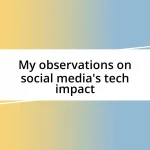Key takeaways:
- Emphasized the importance of agile methodologies and collaboration, enabling quick adaptation to client feedback and fostering innovation.
- Highlighted the critical role of testing and tools such as Trello, VS Code, and Git in enhancing productivity and ensuring code quality.
- Stressed the necessity of continuous learning and adapting processes based on feedback, promoting growth and improved project outcomes.
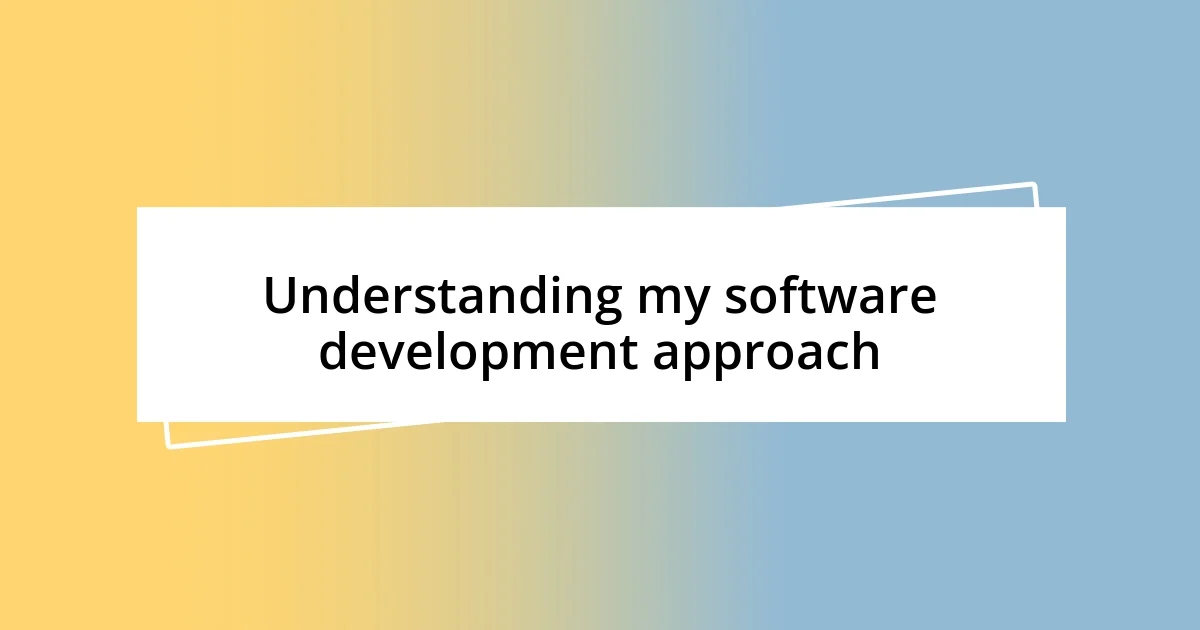
Understanding my software development approach
Understanding my software development approach involves a blend of creativity and structure. I find that embracing agile methodologies helps me adapt quickly to changes and client feedback. For instance, during a recent project, when a client suddenly shifted their priorities, we were able to re-evaluate and pivot within a week, which ultimately led to a product that better met their needs.
I also have a strong belief in the significance of collaboration. Some of my most rewarding moments in development come from brainstorming sessions with my team. I still remember when we tackled a particularly challenging feature; bouncing ideas off one another not only sparked innovative solutions but also fostered a sense of camaraderie. Doesn’t it make sense that innovation often thrives in a supportive environment?
Testing plays a crucial role in my approach as well. I’ve learned that thorough testing can save countless hours later on. Once, I overlooked proper unit tests and paid the price with a frustrating bug that derailed a key demo. That experience toughened my resolve to prioritize testing right from the start. Isn’t it true that sometimes we learn the best lessons from our mistakes?
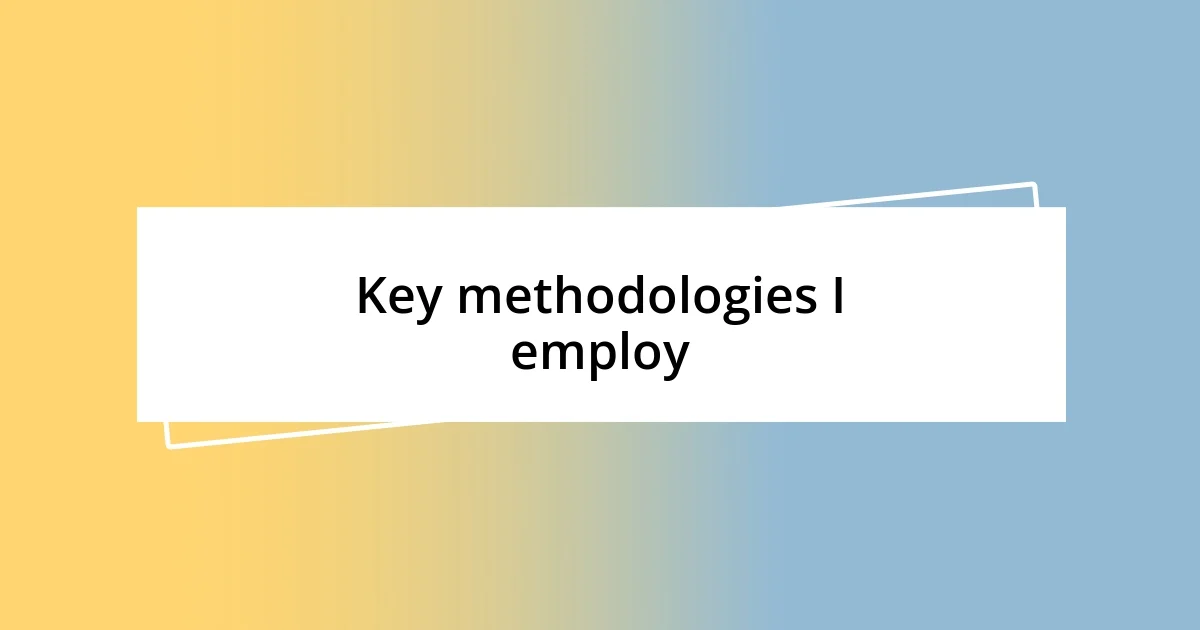
Key methodologies I employ
One core methodology I frequently utilize is Agile, specifically Scrum. I enjoy the structure it provides while staying flexible to change. In one memorable project, we initiated a sprint planning session that unintentionally turned into a brainstorming marathon. The energy was electric! We didn’t just stick to planned tasks but dove into discussions on potential features, which led to the development of an innovative solution that we hadn’t even considered initially.
- Agile (Scrum and Kanban)
- Test-Driven Development (TDD)
- Pair Programming
- Continuous Integration/Continuous Deployment (CI/CD)
Another methodology that resonates with me is Test-Driven Development (TDD). The discipline of writing tests before actual code has significantly shifted my perspective on coding. I recall a time when my focus solely lay on getting features live, but after experiencing a setback with a robust application, I committed to TDD. Not only did it enhance my code quality, but the peace of mind it provides while deploying is incomparable. I find it almost meditative, reinforcing my belief that investing in quality upfront pays off massively in the long run.

Tools that enhance my productivity
Tools play an essential role in my software development workflow. I’ve found that leveraging the right tools can help streamline processes and keep me focused. For example, a tool like Trello has been a game-changer for my project management. I recall starting a project without a clear visual on deadlines, which led to chaotic last-minute scrambles to meet client expectations. Since adopting Trello, I can clearly visualize tasks, prioritize effectively, and maintain a steady workflow. Do you ever feel overwhelmed by the sheer number of tasks? I certainly did before finding tools that organize my thoughts.
Another tool that has significantly enhanced my productivity is Visual Studio Code (VS Code). Its extensibility and customization capabilities make it a preferred choice for my coding sessions. There’s something incredibly satisfying about configuring my environment precisely how I like it. Custom shortcuts and extensions like Prettier for code formatting save me so much time. I remember a project where I spent an entire day refactoring code to adhere to style guidelines before I started using Prettier. The automation freed me up to focus on problem-solving instead of manual formatting, which is incredibly gratifying—don’t you agree?
Lastly, I can’t stress enough the value of version control systems like Git in my daily routine. Git not only helps me keep track of changes but also allows for seamless collaboration with my teammates. I vividly remember a moment when we were racing against a tight deadline. Thanks to Git, a colleague and I could work in parallel without risking overwriting each other’s contributions. The ability to branch off and merge back together made our teamwork incredibly efficient and less stressful. Have you ever faced situations where collaboration felt daunting due to version control? Finding a tool that simplifies this process has truly transformed my workflow.
| Tool | Benefit |
|---|---|
| Trello | Enhanced project organization and visualization |
| Visual Studio Code | Customization and time-saving extensions |
| Git | Version control for efficient collaboration |
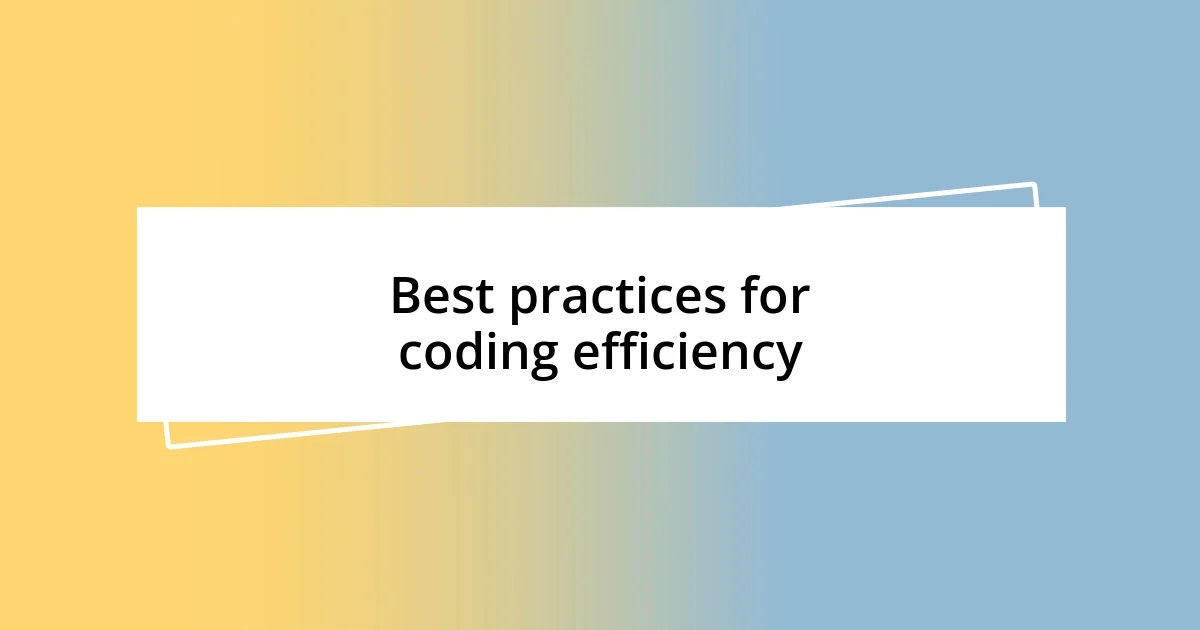
Best practices for coding efficiency
When it comes to coding efficiently, one practice I’ve found invaluable is pair programming. Have you ever collaborated closely with someone on a complex problem? It’s a revelation! One day, my colleague and I tackled a particularly tricky feature together. While I was coding, he offered insights that pointed out potential flaws in my logic. It wasn’t just about writing code; it was about bouncing ideas off each other and refining our approach. That shared experience not only led to a more robust solution but also deepened our understanding of each other’s strengths and weaknesses.
I can’t underestimate the power of consistent code reviews. In my experience, inviting peers to review my code early on helped catch bugs I might overlook. One time, after overlooking a simple error in logic, I was grateful when a teammate pointed it out before anything was pushed to production. It felt like a safety net, ensuring that our code meets a higher standard. The feedback often sparked valuable discussions that enhanced our team’s collective knowledge. It’s like having a buddy on the lookout for pitfalls while you’re navigating a tricky path—definitely a win-win!
Lastly, adopting Continuous Integration/Continuous Deployment (CI/CD) practices made a profound difference in my workflow. I recall the anxiety of waiting for builds to pass before gathering feedback. That tension melted away once I started using CI/CD pipelines. Now, every code change I make triggers automated testing and deployment, allowing me to see immediate results. It’s reassuring knowing my code is thoroughly checked, and it gives me the freedom to experiment. Have you experienced that sense of liberation? For me, it’s a thrilling moment when I know I can confidently push changes that enhance the project without the constant fear of breaking something vital.

Strategies for effective collaboration
One strategy that has proven invaluable in fostering effective collaboration is regular stand-up meetings. When I first joined a new team, we didn’t have daily check-ins, which left a lot of room for miscommunication. Gradually, we adopted a brief morning huddle, and it made all the difference. Sharing updates and expressing any blockers face-to-face (even virtually!) created a sense of unity. Have you ever felt like your team was just drifting apart? I did, until we made that small but impactful change.
Another tactic I can’t recommend enough is fostering an open feedback culture. I remember a project where I hesitated to voice my opinions during discussions, fearing they might be shot down. However, once our team established an environment where constructive feedback was welcomed, I felt empowered to share my ideas freely. It transformed our brainstorming sessions into dynamic discussions. Have you ever held back on sharing your thoughts, only to realize later how valuable they could have been? The earlier you nurture this trust within your team, the more innovative your solutions become.
Lastly, embracing collaborative tools for real-time communication has reshaped my development experience. At first, we relied on email for updates, which often led to misinterpretations. Transitioning to platforms like Slack not only improved our communication speed but also added a layer of informality that encouraged collaboration. I distinctly recall how quickly we resolved a critical bug one afternoon just by bouncing ideas around in a dedicated channel. Have you ever felt bogged down by formal communication? Switching to more agile tools can open up new avenues for creative problem-solving.

Continuous learning and skill development
One of my favorite aspects of software development is the ever-evolving landscape of knowledge. I make it a point to dedicate time each week to learn something new—whether it’s a language, framework, or just a fresh approach to problem-solving. I remember diving into a new programming language that initially left me feeling lost. Yet, after investing time in online courses and experimenting through projects, I felt a rush of achievement when I finally built something functional. Have you ever pushed through a steep learning curve? The satisfaction makes it worthwhile.
Networking with fellow developers has also vastly expanded my perspective on skill development. Attending meetups and conferences has introduced me to innovative ideas and practices that I would never have encountered in my own bubble. I still recall a session that demystified machine learning; it ignited a spark in me. I left that event not just inspired, but eager to explore and integrate those concepts into my work. Connecting with others can deeply enrich our learning journey, don’t you think?
Lastly, I’ve learned that embracing failures is a crucial part of continuous learning. Our team once launched a project that didn’t meet user expectations—a tough pill to swallow. However, rather than wallow in disappointment, we organized a retrospective. Analyzing what went wrong brought invaluable insights, ultimately sharpening our skills and understanding. How often do we let setbacks shape our future success? For me, this experience underscored that every misstep is a stepping stone toward growth.
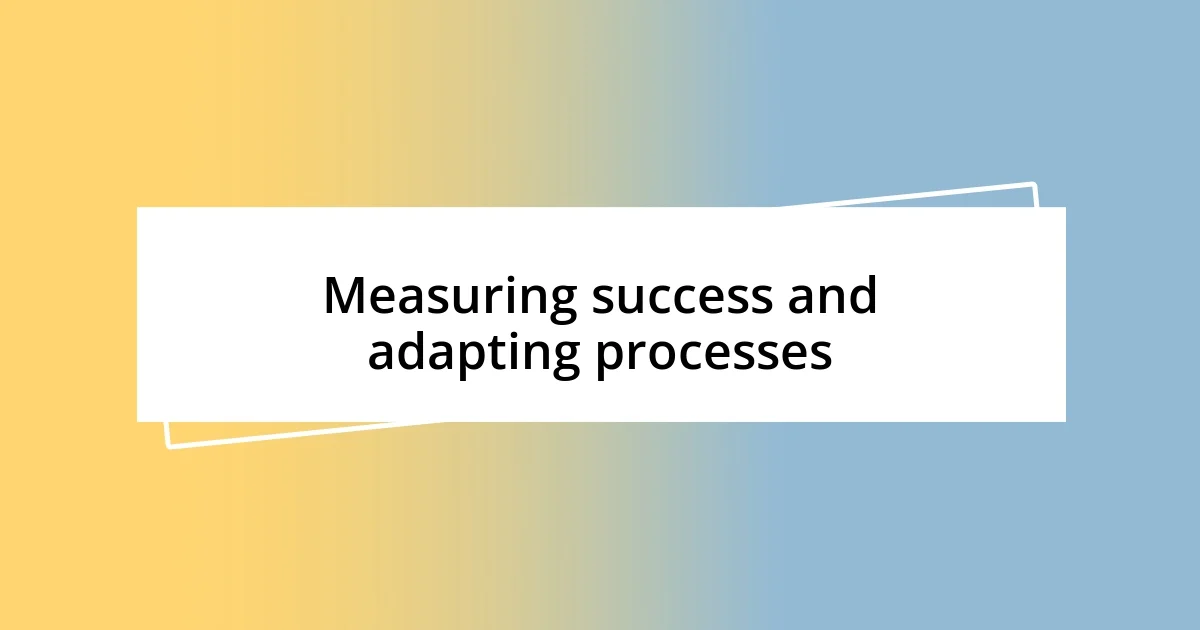
Measuring success and adapting processes
Measuring success in software development often requires more than just tracking project milestones—it’s about understanding the impact of those milestones on the end users. For instance, during a recent project, we implemented a feature we believed would delight our users. Initially, we celebrated its launch, but after a few weeks, we took a hard look at user feedback and analytics. Surprisingly, usage was much lower than expected. Have you ever faced a situation where your assumptions didn’t match reality? It taught us that success isn’t just about delivery; it’s about delivering value.
Adapting our processes along the way is where I find the greatest growth in our projects. I vividly remember a sprint where we hit a wall with our coding practices. Some of my teammates were resistant to adjusting our workflow, fearing it would slow us down. But by introducing code reviews and pair programming, we saw a significant turnaround in both the quality of our work and our team’s cohesion. Have you ever hesitated to change a process, only to realize it was necessary for improvement? These moments reaffirm my belief that flexibility is key to ongoing success.
Regularly revisiting our goals also helps in assessing whether we’re truly on the right path. I’ve been part of sessions where we’d evaluate our progress and ask ourselves tough questions about our objectives. One such session led to reshaping our project entirely based on newfound insights. It felt a bit daunting at first, but that courage to ask and adapt was exactly what we needed. How can we know if we’re moving in the right direction without pausing to assess? Fostering this reflective practice has become a cornerstone of our team’s culture, ensuring we grow not just in output but in purpose, too.










